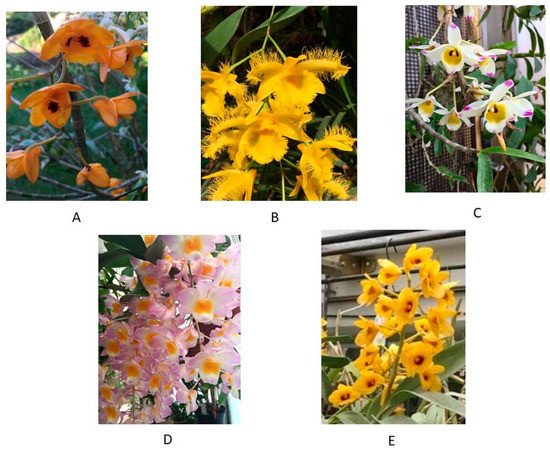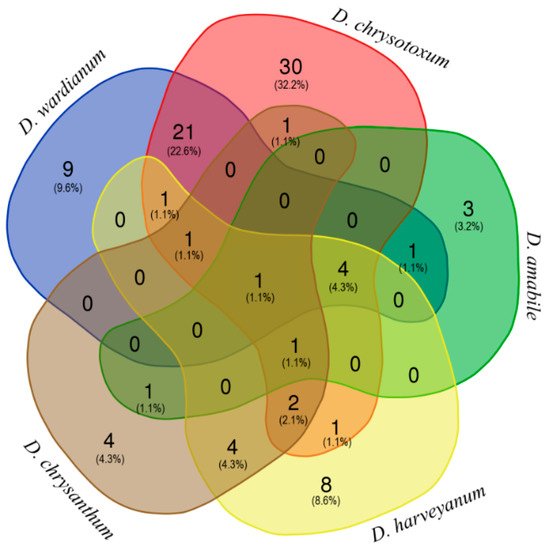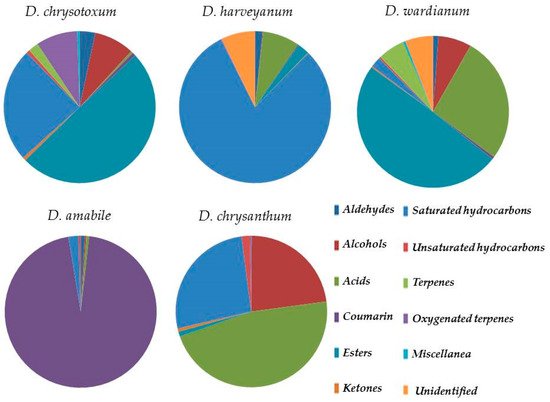1000/1000
Hot
Most Recent

A detailed chemical composition of Dendrobium essential oil has been only reported for a few main species. This article is the first to evaluate the essential oil composition, obtained by steam distillation, of five Indian Dendrobium species: Dendrobium chrysotoxum Lindl., Dendrobium harveyanum Rchb.f., and Dendrobium wardianum R.Warner (section Dendrobium), Dendrobium amabile (Lour.) O’Brien, and Dendrobium chrysanthum Wall. ex Lindl. (section Densiflora). We investigate fresh flower essential oil obtained by steam distillation, by GC/FID and GC/MS. Several compounds are identified, with a peculiar distribution in the species: Saturated hydrocarbons (range 2.19–80.20%), organic acids (range 0.45–46.80%), esters (range 1.03–49.33%), and alcohols (range 0.12–22.81%). Organic acids are detected in higher concentrations in D. chrysantum, D. wardianum, and D. harveyanum (46.80%, 26.89%, and 7.84%, respectively). This class is represented by palmitic acid (13.52%, 5.76, and 7.52%) linoleic acid (D. wardianum 17.54%), and (Z)-11-hexadecenoic acid (D. chrysantum 29.22%). Esters are detected especially in species from section Dendrobium, with ethyl linolenate, methyl linoleate, ethyl oleate, and ethyl palmitate as the most abundant compounds. Alcohols are present in higher concentrations in D. chrysantum (2.4-di-tert-butylphenol, 22.81%), D. chrysotoxum (1-octanol, and 2-phenylethanol, 2.80% and 2.36%), and D. wardianum (2-phenylethanol, 4.65%). Coumarin (95.59%) is the dominant compound in D. amabile (section Densiflora) and detected in lower concentrations (range 0.19–0.54%) in other samples. These volatile compounds may represent a particular feature of these plant species, playing a critical role in interacting with pollinators.



| Compound a | RI b | RI c | Section Dendrobium | Section Densiflora | ||||
|---|---|---|---|---|---|---|---|---|
| D. chrysotoxum | D. harvejanum | D. wardianum | D. amabile | D. chrysanthum | Identification d | |||
| % | % | % | % | % | ||||
| Octane | 800 | 800 | - | 0.15 | - | - | - | RI, NIST |
| Hexanal | 802 | 801 | 0.73 | 0.06 | 0.02 | - | - | RI, NIST |
| 2-hexanol | 804 | 808 | - | 0.12 | - | - | - | RI, NIST |
| Diacetone alcohol | 841 | 841 | - | - | - | - | 0.68 | RI, NIST |
| α-pinene | 939 | 931 | 0.21 | - | - | - | - | MS, NIST |
| Benzaldehyde | 960 | 958 | 0.14 | - | - | - | - | RI, NIST |
| β-pinene | 979 | 973 | 0.03 | - | - | - | - | MS, NIST |
| Caproic acid | 1005 | 1003 | 0.06 | - | - | - | - | RI, NIST |
| α-terpinene | 1017 | 1015 | 0.10 | - | - | - | - | RI, NIST |
| o-Cymene | 1026 | 1023 | 0.09 | - | - | - | - | RI, NIST |
| Limonene | 1029 | 1027 | 0.17 | - | - | - | - | RI, NIST |
| Benzyl alchol | 1032 | 1035 | 0.21 | - | 0.52 | - | - | RI, NIST |
| β-Isophorone | 1042 | 1041 | 0.51 | - | - | - | RI, NIST | |
| Phenylacetaldehyde | 1042 | 1043 | 0.84 | - | 0.06 | - | - | RI, NIST |
| 2-octenal | 1056 | 1058 | - | 0.13 | - | - | 0.06 | RI, NIST |
| γ-Terpinene | 1060 | 1059 | 0.76 | - | 0.04 | - | - | RI, NIST |
| Unidentified | - | 1065 | - | - | 2.89 | - | - | - |
| cis-sabinene hydrate | 1070 | 1067 | 0.27 | - | - | - | - | MS, NIST |
| dihydromyrcenol | 1073 | 1073 | - | 0.04 | - | - | 0.06 | RI, NIST |
| 1-octanol | 1070 | 1074 | 2.80 | - | 0.41 | - | - | MS, NIST |
| trans-sabinene hydrate | 1098 | 1098 | 0.20 | - | - | - | - | RI, NIST |
| Linalool | 1097 | 1101 | 0.34 | 0.08 | - | - | - | MS, NIST |
| Nonanal | 1102 | 1105 | - | 0.16 | - | - | - | RI, NIST |
| 2-phenylethanol | 1107 | 1115 | 2.36 | - | 4.65 | - | - | MS, NIST |
| Methyl octanoate | 1127 | 1127 | 0.04 | - | - | - | - | RI, NIST |
| cis-verbenol | 1141 | 1142 | 0.92 | - | - | - | - | RI, NIST |
| trans-verbenol | 1145 | 1148 | 4.60 | - | - | - | - | RI, NIST |
| Camphor | 1150 | 1157 | - | 0.12 | - | - | - | MS, NIST |
| Nonenal | 1162 | 1161 | 0.41 | - | 0.17 | - | - | RI, NIST |
| α-phellandren-8-ol | 1170 | 1169 | 2.15 | - | - | - | - | RI, NIST |
| Terpinen-4-ol | 1177 | 1179 | 1.53 | - | - | - | - | RI, NIST |
| Diethyl succinate | 1182 | 1184 | 0.33 | - | - | - | - | RI, NIST |
| p-cymen-8-ol | 1183 | 1186 | 0.29 | - | - | - | - | RI, NIST |
| α-terpineol | 1189 | 1192 | 0.18 | - | - | - | 0.28 | RI, NIST |
| Ethyl octanoate | 1196 | 1199 | 0.20 | - | - | - | - | RI, NIST |
| Decanal | 1202 | 1206 | - | - | 0.04 | - | - | RI, NIST |
| Verbenone | 1205 | 1210 | 0.20 | - | - | - | - | MS, NIST |
| 2,4-nonandienal | 1212 | 1214 | - | - | 0.03 | - | - | RI, NIST |
| 4-vinylphenol | 1224 | 1221 | - | - | 0.52 | 0.08 | - | RI, NIST |
| 3-phenyl-1-propanol | 1232 | 1231 | - | - | 0.08 | - | - | RI, NIST |
| Phenylacetic acid ethyl ester | 1247 | 1247 | 0.15 | - | 0.72 | - | - | RI, NIST |
| Nerol | 1254 | 1256 | 0.06 | - | - | - | - | RI, NIST |
| 2,4-decadienal (E,E) | 1291 | 1295 | 0.40 | 0.39 | 0.39 | 0.16 | - | RI, NIST |
| 2-methoxy-4-vinyl-phenol | 1315 | 1315 | - | - | 0.24 | - | - | RI, NIST |
| 2,4-decadienal (E,Z) | 1319 | 1317 | 0.63 | 0.88 | 0.48 | 0.72 | RI, NIST | |
| 2-nonenoic acid-γ-lactone | 1345 | 1344 | 0.39 | - | 0.49 | - | - | RI, NIST |
| Capric acid | 1359 | 1359 | - | 0.32 | - | RI, NIST | ||
| Eugenol | 1367 | 1366 | - | - | - | 0.10 | - | RI, NIST |
| 1-tetradecene | 1390 | 1393 | - | 0.07 | - | 0.57 | MS, RI | |
| 3,4-dihydrocoumarin | 1398 | 1399 | - | - | - | 0.10 | - | RI, NIST |
| Coumarin | 1434 | 1436 | 0.71 | 0.19 | 0.54 | 95.49 | - | RI, NIST |
| 9-epi-(E)-caryophyllene | 1466 | 1458 | - | - | 1.32 | - | - | MS, NIST |
| Ethyl-cinnammate | 1467 | 1468 | - | - | 0.55 | - | - | RI, NIST |
| 2,4-di-tert-butylphenol | 1494 | 1489 | - | 0.12 | 22.81 | MS, NIST | ||
| β-selinene | 1494 | 1489 | 0.25 | - | 1.30 | - | - | MS, NIST |
| 9-oxo-ethyl-nonanoate | 1507 | 1510 | 1.28 | - | - | - | - | MS, NIST |
| Lauric acid | 1566 | 1568 | 0.23 | - | - | - | - | RI, NIST |
| Ethyl laurate | 1593 | 1596 | 0.15 | - | - | - | - | RI, NIST |
| Unidentified | - | 1658 | - | 5.16 | - | - | - | - |
| Pentadecan-2-one | 1667 | 1667 | - | - | 0.26 | - | - | RI, NIST |
| Heptadecane | 1700 | 1700 | 0.31 | - | 0.54 | - | - | RI, NIST |
| Unidentified | - | 1767 | 0.39 | - | 3.04 | - | - | - |
| Myristic acid | 1780 | 1776 | - | 3.59 | - | - | MS, NIST | |
| 1-octadecene | 1790 | 1796 | 0.32 | - | 0.41 | - | - | MS, RI |
| Methyl pentadecanoate | 1820 | 1828 | 0.04 | - | - | - | - | MS, NIST |
| Unidentified | - | 1879 | 5.74 | - | - | - | - | - |
| Ethyl pentadecanoate | 1890 | 1896 | 0.36 | - | 0.19 | - | - | MS, NIST |
| Heptadecan-2-one | 1902 | 1903 | 0.11 | - | - | - | RI, NIST | |
| Methyl palmitate | 1927 | 1928 | 0.34 | - | 0.44 | - | - | RI, NIST |
| cis-9-hexadecenoic acid | 1942 | 1943 | - | - | - | - | 4.06 | RI, NIST |
| Z-11-Hexadecenoic acid | 1953 | 1953 | - | - | - | - | 29.22 | RI, NIST |
| Palmitic acid | 1958 | 1960 | 0.05 | 7.52 | 5.76 | 0.61 | 13.52 | RI, NIST |
| Neocembrene | 1960 | 1966 | 0.52 | - | 3.07 | - | - | MS, NIST |
| Ethyl palmitate | 1992 | 1997 | 3.05 | - | 0.99 | - | - | MS, NIST |
| Octadecan-1-ol | 2074 | 2071 | 0.17 | - | 0.60 | - | - | MS, NIST |
| Eicosane | 2000 | 2000 | - | 40.42 | - | - | 0.55 | RI, NIST |
| Unidentified | - | 2037 | - | 2.06 | - | - | - | |
| Methyl linoleate | 2051 | 2068 | 7.48 | 2.50 | 13.17 | - | 1.03 | MS, NIST |
| 10-Heneicosene | 2060 | 2073 | - | - | - | 0.43 | - | MS, RI |
| Heneicosane | 2100 | 2100 | 1.01 | 2.92 | 1.66 | 0.25 | - | RI, NIST |
| Linoleic acid | 2144 | 2147 | 0.12 | - | 17.54 | - | - | RI, NIST |
| Ethyl linolenate | 2169 | 2171 | 26.98 | - | 32.24 | - | - | RI, NIST |
| Ethyl oleate | 2179 | 2181 | 5.39 | - | 0.72 | - | - | RI, NIST |
| Ethyl octadecanoate | 2193 | 2198 | 0.80 | - | 0.31 | - | - | RI, NIST |
| Docosane | 2200 | 2204 | 1.66 | 26.82 | - | 1.94 | 17.53 | RI, NIST |
| 9-Triacosene | 2279 | 2275 | 0.31 | - | - | - | - | MS, RI |
| Tricosane | 2300 | 2307 | 9.33 | - | - | - | - | RI, NIST |
| Tetracosane | 2400 | 2401 | 0.40 | 0.90 | - | - | 2.07 | RI, NIST |
| 9-Pentacosene | 2474 | 2475 | 0.07 | - | - | MS, RI | ||
| Pentacosane | 2500 | 2501 | 0.95 | 6.53 | - | - | 6.40 | RI, NIST |
| Hexacosane | 2600 | 2600 | - | 2.46 | - | - | - | RI, NIST |
| 9-Eptacosene | 2676 | 2676 | - | - | - | - | 1.15 | MS, RI |
| Heptacosane | 2700 | 2701 | 0.18 | - | - | - | - | RI, NIST |
| Aldehydes | 3.15 | 1.62 | 1.20 | 0.88 | 0.06 | |||
| Alcohols | 7.97 | 0.12 | 7.02 | 0.30 | 22.81 | |||
| Acids | 0.45 | 7.84 | 26.89 | 0.61 | 46.80 | |||
| Coumarin | 0.71 | 0.19 | 0.54 | 95.59 | - | |||
| Esters | 46.59 | 2.50 | 49.33 | - | 1.03 | |||
| Ketones | 0.62 | 0.12 | 0.26 | - | 0.68 | |||
| Saturated hydrocarbons | 22.84 | 80.20 | 2.20 | 2.19 | 26.55 | |||
| Unsaturated hydrocarbons | 0.69 | 0.07 | 0.41 | 0.43 | 1.72 | |||
| Terpenes | 2.04 | - | 5.73 | - | - | |||
| Oxygenated terpenes | 8.31 | 0.11 | - | - | 0.34 | |||
| Miscellanea | 0.48 | - | 0.49 | - | - | |||
| Unidentified | 6.13 | 7.22 | 5.92 | - | - | |||